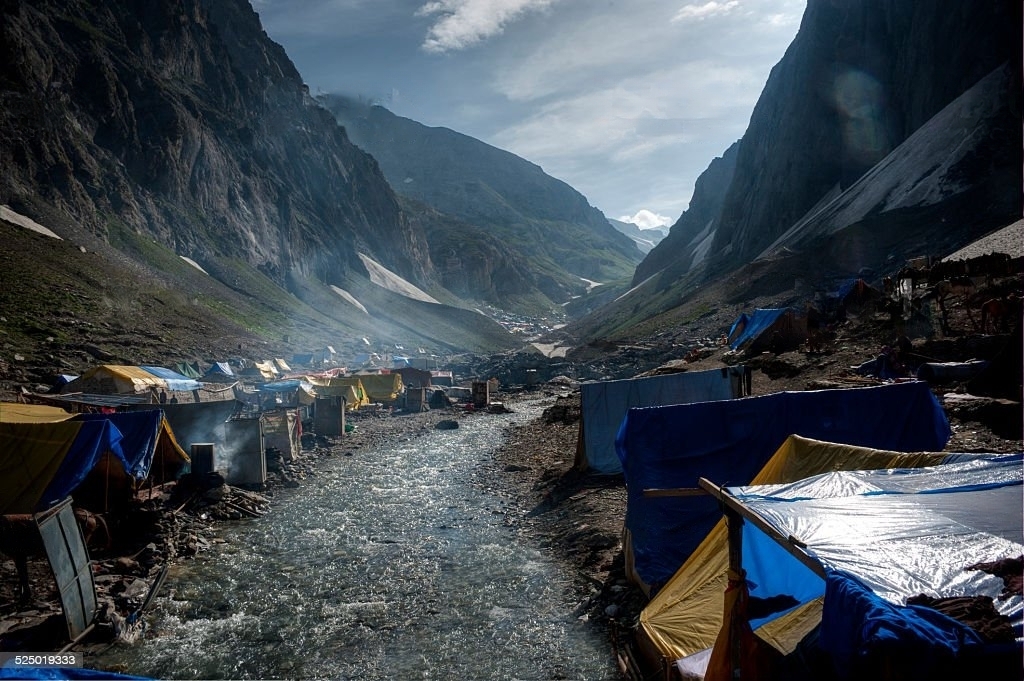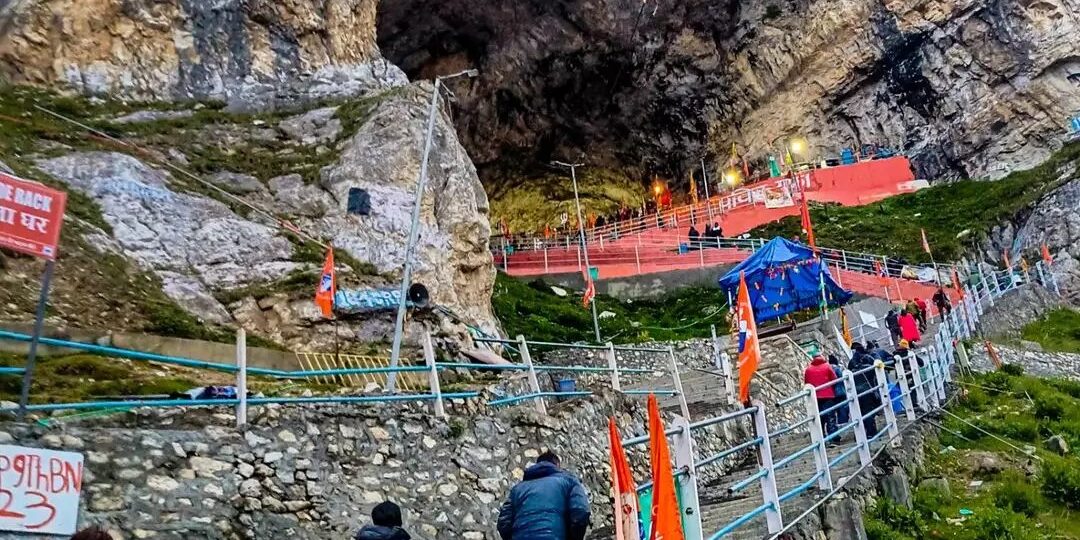Table of Contents
Amarnath Yatra Introduction
The Amarnath Yatra, a celestial pilgrimage nestled amidst the majestic Himalayas in the northern state of Jammu and Kashmir, is a journey of profound spiritual significance for millions of devout Hindus. This annual yatra holds the essence of divinity as it leads devotees to the sacred Amarnath Cave, where the divine presence of Lord Shiva is believed to manifest as a naturally formed ice lingam.
Amidst the breathtaking beauty of snow-capped mountains and serene landscapes, the Amarnath Yatra stands as a testament to the unwavering faith and devotion of pilgrims who embark on this soul-stirring odyssey. The pilgrimage, spanning over a few weeks during the summer months, witnesses a sea of pilgrims from various corners of the world, united in their quest for spiritual enlightenment and blessings.
Significance of the Pilgrimage
The significance of the Amarnath Yatra can be traced back to ancient Hindu scriptures and legends. According to mythology, it was in the hallowed confines of the Amarnath Cave that Lord Shiva chose to reveal the secrets of eternity and creation to his beloved consort, Goddess Parvati. The divine ice lingam that forms naturally inside the cave every year is seen as a symbolic representation of this immortal revelation, bestowing upon devotees a sense of eternal connection with the divine.
Undertaking the Amarnath Yatra is considered a profound act of devotion and penance, as it is believed to cleanse the soul of past sins and lead to spiritual liberation. The journey itself is a testimony to the unwavering determination and dedication of the pilgrims, who brave challenging terrains and weather conditions to seek the blessings of Lord Shiva.
Beyond its religious significance, the Amarnath Yatra is a celebration of unity and brotherhood, as people from diverse backgrounds come together to partake in this sacred pilgrimage. The camaraderie among fellow travelers, sharing of stories, and singing of hymns create an atmosphere of unparalleled spirituality and harmony.
In the subsequent sections of this guide, we shall delve into the mesmerizing aspects of the Amarnath Yatra, covering everything from the preparation for the sacred journey, and the enchanting rituals and traditions, to the responsible practices that uphold the sanctity of this revered pilgrimage. Join us on this spiritual expedition, as we unravel the secrets and marvels of the Amarnath Yatra.
Preparing for the Sacred Journey
Choosing the best time to Travel
Before embarking on the Amarnath Yatra, one of the key considerations is the timing of the pilgrimage. The Yatra takes place during the summer months, typically from June to August. Among these months, the period around July and August witnesses the highest number of pilgrims due to favorable weather conditions and accessibility.
The weather during the yatra is relatively pleasant, with daytime temperatures ranging from 15 to 20 degrees Celsius. However, the nights can be cold, with temperatures dropping to around 5 degrees Celsius or even lower. Pilgrims are advised to plan their journey during these months to avoid harsh weather conditions and ensure a comfortable and safe pilgrimage.
Obtaining Required Permissions and Permits
For undertaking the Amarnath Yatra, obtaining the necessary permissions and permits is of utmost importance. The yatra is managed by the Shri Amarnathji Shrine Board (SASB), and all pilgrims must obtain a yatra permit before proceeding on the journey. The permit ensures a systematic and organized pilgrimage, enhancing the safety and well-being of the devotees.
There are two types of permits required for the yatra: the Compulsory Health Certificate (CHC) and the Yatra Permit. The CHC is a medical certificate issued by authorized doctors, certifying the fitness of the pilgrim for the arduous journey. The Yatra Permit, on the other hand, is a document that allows the pilgrim to participate in the yatra and must be obtained from the SASB.
The registration process for Amarnath Yatra
The registration process for the Amarnath Yatra has been made convenient to accommodate a large number of pilgrims. It can be done either through an online registration portal or at designated registration centers. The online registration process allows pilgrims to select their preferred route, dates, and other necessary details.
For those who prefer offline registration, the designated registration centers across different states facilitate the process. Pilgrims can submit their application forms along with the required documents and fees at these centers to secure their place for the Yatra.
Essential items to carry on Yatra
As the Amarnath Yatra involves trekking through challenging terrains, it is essential to pack the right items to ensure a comfortable journey. Pilgrims are advised to carry warm clothing, sturdy trekking shoes, and rainproof gear to tackle changing weather conditions. Essential personal items such as identity proof, water bottles, torchlights, and dry snacks should also be included in the backpack.
Accommodation Option
Budget-friendly hotels and lodges near the pilgrimage site offer basic amenities for a comfortable stay. For those seeking a luxurious experience, there are retreats and resorts that provide premium services and facilities. Visit Travellency for making the arrangements for your smooth bookings.

Temperature Conditions and Tips: Be Prepared for the Journey
The Amarnath Yatra, set amidst the majestic Himalayan ranges, presents diverse weather conditions that can catch pilgrims off-guard. As pilgrims traverse through varying terrains and altitudes, the temperatures fluctuate significantly, necessitating careful preparation for both warm and cold conditions.
Unpredictable Weather
The weather during the yatra season, which typically spans from June to August, can be highly unpredictable. While daytime temperatures may rise to pleasant levels, reaching around 15 to 20 degrees Celsius, the nights can turn chilly, with temperatures plummeting to 5 degrees Celsius or even lower. Additionally, sudden rain showers and unexpected weather changes are not uncommon.
Appropriate Clothing
To tackle the fluctuating temperatures, it is crucial for pilgrims to pack appropriate clothing. Layering is the key to staying comfortable during the yatra. Light, breathable clothing is ideal for daytime trekking, while warm layers such as thermals, fleece jackets, and windproof outerwear are essential for chilly evenings and early mornings.
Coping with High Altitude
The Amarnath Yatra involves trekking at high altitudes, which can pose challenges to the physical well-being of pilgrims. Altitude sickness is a common concern, and acclimatization is vital to prevent its onset. Pilgrims are advised to ascend gradually, taking sufficient breaks and allowing their bodies to adjust to the changing altitude.
Hydration and Nutrition
Staying hydrated is crucial at higher altitudes to combat the effects of reduced oxygen levels. Pilgrims should carry an adequate supply of water and drink fluids regularly throughout the journey. Additionally, maintaining a balanced diet that includes nutritious food items rich in carbohydrates and proteins is essential for sustaining energy during the trek.
Health Precautions
Prior to embarking on the yatra, pilgrims are advised to undergo a thorough medical check-up to assess their fitness levels. Individuals with pre-existing health conditions should consult their doctors and seek medical clearance before participating in the pilgrimage. Basic medications for common ailments, such as headaches and colds, should be included in the first aid kit.
Stay Informed
It is essential for pilgrims to stay updated on weather forecasts and any potential changes in yatra schedules. Being informed about the current conditions helps in planning the journey efficiently and making timely decisions regarding the trek.
Spirit of Preparedness
With unpredictable weather and altitude challenges, pilgrims must embrace a spirit of preparedness throughout the Amarnath Yatra. Packing smart, adopting responsible trekking practices, and maintaining good health ensure a safe and fulfilling pilgrimage experience amidst the awe-inspiring landscapes of the Himalayas.
Spiritual Experience and Rituals
The Amarnath Yatra is not merely a physical journey but also a spiritual quest. Devotees engage in various rituals and prayers during the pilgrimage, fostering a deep connection with the divine. Inspirational stories of pilgrims who experienced spiritual transformations during the yatra inspire others to embark on this sacred journey.
Modes of Transportation: By Air, Train, Road
While the cave is located in a remote and challenging terrain, several transportation options ensure accessibility for pilgrims from various parts of India.
By Air
The closest airport to Amarnath is the Srinagar International Airport, located approximately 70 kilometers away from the base camp of the yatra. The airport is well-connected to major cities in India through regular flights. From the airport, pilgrims can hire taxis or avail of pre-arranged transport services to reach the starting points of the yatra, such as Baltal or Pahalgam.
By Train
The nearest railway station to Amarnath is the Jammu Tawi Railway Station, situated around 270 kilometers from the pilgrimage site. Jammu Tawi is well-connected to major cities across the country. After arriving at the railway station, pilgrims can avail of private taxis, buses, or other modes of transportation to reach the base camp of the yatra.
By Road
For those traveling by road, the journey to Amarnath can be undertaken through various routes, depending on the chosen starting point. The two main base camps for the yatra are Baltal and Pahalgam.
- Baltal Route: The Baltal route is shorter but relatively steeper. Pilgrims traveling to Baltal can reach the site via road from Srinagar. Regular bus services and private taxis operate from Srinagar to Baltal.
- Pahalgam Route: The Pahalgam route is longer but offers a more gradual ascent. Pilgrims can travel to Pahalgam by road from Srinagar or Jammu. Numerous bus services and private taxis are available for this route as well.
Helicopter Services
For those seeking convenience and time efficiency, helicopter services are available for the Amarnath Yatra. Helicopter rides offer a swift and comfortable journey, providing stunning aerial views of the surrounding landscapes. Helicopter services are available from Srinagar to the holy cave.
It is essential for pilgrims to plan their travel well in advance, especially during the yatra season, to ensure availability and a hassle-free journey. The yatra authorities, along with the state government, take proactive measures to ensure smooth connectivity and transportation options, making the pilgrimage accessible to pilgrims from all over the country.

Medical Facilities and Emergency Services: Ensuring Pilgrim Safety
During the Amarnath Yatra, the well-being of pilgrims is of utmost importance. To cater to the health needs of the travelers, medical camps and facilities are strategically set up along the yatra route. These medical stations are equipped to provide immediate assistance and care to pilgrims who may require medical attention.
In the event of unforeseen emergencies, such as injuries or health complications, specialized emergency services are readily available to handle such situations efficiently. These services include timely evacuation facilities to transport pilgrims to nearby medical centers for comprehensive treatment.
To ensure personal safety, pilgrims are strongly encouraged to carry a basic first aid kit containing essential medical supplies, such as bandages, antiseptics, pain relievers, and other necessary items. Taking necessary precautions, like staying hydrated and adhering to safety guidelines, plays a crucial role in preventing health issues during the pilgrimage.
The presence of medical facilities and emergency services along the yatra route offers pilgrims a sense of reassurance, knowing that their well-being is well taken care of throughout the sacred journey.
Cultural Significance of Amarnath Yatra: Nurturing Heritage and Fostering Community
Beyond its profound religious significance, the Amarnath Yatra holds a special place in preserving the rich cultural heritage of the region. As pilgrims embark on this sacred journey to seek the blessings of Lord Shiva, they become an integral part of an age-old tradition that has endured for centuries.
The pilgrimage serves as a platform for the exchange and preservation of cultural practices, beliefs, and traditions. Along the yatra route, pilgrims interact with local communities, immersing themselves in the vibrant tapestry of local customs and rituals. The warmth and hospitality of the locals create an environment of unity and harmony, bridging the gap between diverse cultures and backgrounds.
The Amarnath Yatra plays a vital role in bolstering the region’s economy. The influx of pilgrims brings economic opportunities to local businesses, including accommodation providers, food vendors, and souvenir shops. The pilgrimage season breathes life into the local economy, contributing significantly to the livelihoods of the people residing in the surrounding areas.
Moreover, the yatra also encourages local artisans and craftsmen to showcase their traditional skills, such as crafting intricate handicrafts, souvenirs, and religious artifacts. By purchasing these handcrafted items, pilgrims not only support local artists but also carry a piece of the region’s cultural essence back home.
However, with the increase in the number of pilgrims, the fragile Himalayan ecosystem faces ecological challenges. To ensure the sustainable preservation of this pristine environment, responsible tourism practices are highly encouraged. Authorities and yatra organizers promote eco-friendly measures, waste management systems, and awareness campaigns to minimize the ecological footprint of the pilgrimage.
Preserving the cultural significance of the Amarnath Yatra is intrinsically tied to safeguarding the natural heritage of the region. The pilgrimage reinforces the sense of responsibility and stewardship towards the environment, fostering a harmonious coexistence between human endeavors and nature’s magnificence.
As pilgrims undertake this spiritual odyssey, they become not just participants in a religious ritual, but also custodians of the cultural and ecological legacy that defines the Amarnath Yatra. The experience imprints a profound understanding of the interconnectedness between human spirituality, cultural heritage, and environmental conservation.
The Amarnath Yatra stands as a testament to the enduring power of culture and faith, where every step taken by the pilgrims symbolizes a commitment to preserving the essence of this sacred pilgrimage for generations to come. In embracing responsible practices and fostering a deep sense of respect for the land and its people, the Amarnath Yatra continues to be a transformative journey, enriching the lives of pilgrims and nurturing the cultural soul of the Himalayan region.
Dining and Food Options
During the yatra, pilgrims can savor traditional Kashmiri cuisine and local delicacies. Various dining options are available, ranging from simple eateries to langar (community kitchen) services. Pilgrims can relish the regional flavors and cultural diversity of the area.
Photography and Photography Tips
The scenic beauty of the Amarnath Yatra offers ample opportunities for photography enthusiasts. Capturing the breathtaking landscapes, snow-capped mountains, and moments of spiritual fervor can create cherished memories. However, pilgrims are advised to follow photography guidelines to respect the sanctity of the pilgrimage.
Sustainable Tourism and Responsible Practices
With the increasing number of pilgrims, sustainable tourism practices are crucial to preserve the pristine beauty of the region. Pilgrims are encouraged to minimize waste, use eco-friendly products, and respect the local culture and environment. Responsible practices can help protect the Himalayan ecosystem for future generations.
In the enchanting embrace of the Amarnath Yatra, we find a timeless connection between faith, culture, and the resplendent Himalayan landscapes. Beyond its religious significance, this sacred pilgrimage is a tapestry that weaves together the threads of diverse cultures, fostering unity and harmony. As we tread the sacred paths, we are not just seekers of divine blessings, but guardians of cultural heritage and stewards of nature’s grace. Let us embark on this transformative journey with reverence and responsibility, preserving the sanctity of the Amarnath Yatra, and in doing so, discovering the eternal harmony that binds us to the soul of this hallowed land.


tadalafil daily dose